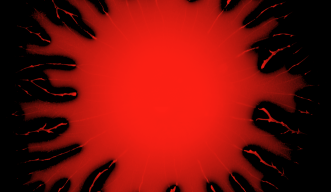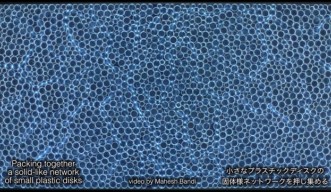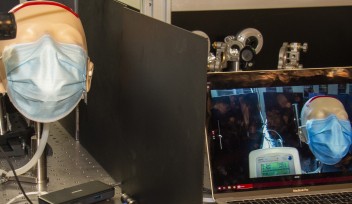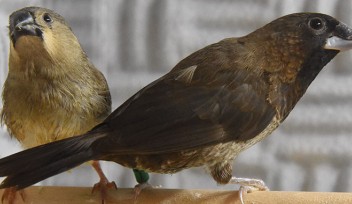New Unit Profile: Getting to the Heart of the Matter

In talking with Professor Mahesh Bandi you may notice he peppers interesting facts into the dialogue about what we know or don’t know, or came to know in physics. Bandi’s research interests lie in finding links between seemingly unrelated areas, such as pond scum’s geometrical patterns, airborne fungal spores, or carbon sequestration. In his Collective Interactions Unit, the team attempts to bridge fields of science through analogy.
Their research to simulate theoretical phenomena means they take a potentially expensive and complex field experiment and bring it to a “table-top” one. These experiments stretch from inner space to outer space: from visualizing the fluid around a simulated fish tail to looking for a black hole using soap film. They do not specialize in a particular field— only in their experimental approach.
“Theory is an abstraction of reality. Experiment is reality. It’s a symbiotic process,” he says.
The Collective Interactions unit teases apart how the individual components, which make up a material, interact by creating a blown-up view of them in a controlled experiment. “We study at a scale we can all see,” says Bandi, “though the problems that arise are inspired by smaller scales.” By mimicking a solid like sandstone on a larger scale using a network of plastic grains in the lab, they can understand mechanisms like those behind earthquakes.
Some of the problems highlighted in this lab fall into a branch of physics called soft matter. Bubbles, mud, plastics, mayonnaise, and even toothpaste exist under this definition, which can be squishy, since they are easily deformed by external stresses, and don’t always behave as categorized. Bubbles can collectively act like solids, and sand grains of an hourglass can flow like a fluid.
Often labs tackle one big problem, and though their name suggests collaboration, the Collective Interactions members each tackle separate problems. The diverse team of postdoctoral researchers is also indicative of the gamut of research they cover. They hail from Turkey, India, and France; one is a theorist, one studies fluids and the other specializes in solids. They seek to fully understand the complex relationships between materials that may appear as simple interactions to the casual observer, such as tiny plastic pieces floating on waves.
Their equipment is simple: cameras, soap bubbles, syringes, and soft plastic beads. Imaging is key for all of them- especially for Jean-Francois Metayer, who wants to know what happens to the individual particles when they pack together as a solid. He measures where stress occurs along individual photo-elastic disks by squeezing hundreds of them beneath a polarizing lens. Ceyda Sanli investigates why certain fluids split and come together again like the wine legs in a glass. She replicates this by meticulously monitoring small amounts of chloroform and ethanol. Tamoghna Das creates a frictionless fabric of bubbles to determine how they rip apart like a zipper.
“Collective Interactions is the only title that can put us under the same hood,” says Das.
Most members have just arrived to OIST so their current experiments are still in the developmental stages, but these seemingly simple experiments require an exacting approach: perfectly pressured injections or nearly undetectable measurements of velocity. “Frustration is an every day thing. The experiment doesn’t go as fast as you would like,” says Metayer. But getting results that no one else has, he says, is a remarkable feeling.
For Das, mastering the art of stable bubble making isn’t easy; he’s stepped outside his theoretical world and into his first experimental one. “I can now see what I used to model on a computer. I can see how things are really moving, and that is really exciting,” he says.
The Collective Interactions Unit makes the details behind many theories more palpable. By studying phenomena that can be seen with the naked eye, they cross into any subject that is corporeal. “We seek the freedom to think about problems irrespective of a field,” says Bandi.
With OIST’s interdisciplinary mission, they’ll get to do just that.
Specialties
Research Unit
For press enquiries:
Press Inquiry Form

















